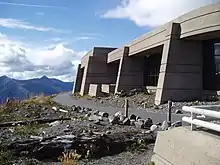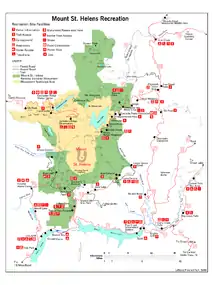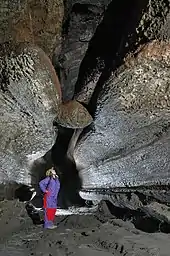Mount St. Helens National Volcanic Monument
Mount St. Helens National Volcanic Monument is a U.S. National Monument that includes the area around Mount St. Helens in Washington. It was established on August 27, 1982, by U.S. President Ronald Reagan, following the 1980 eruption.[2] The 110,000 acre (445 km2) National Volcanic Monument was set aside for research, recreation, and education. Inside the monument, the environment is left to respond naturally to the disturbance.[3] It was the third national monument to be managed by the U.S. Forest Service.
| Mount St. Helens National Volcanic Monument | |
|---|---|
 Mount St. Helens from the Johnston Ridge Observatory (July 2018) | |
  | |
| Location | Skamania / Cowlitz / Lewis counties, Washington, United States |
| Nearest city | Castle Rock, Washington |
| Coordinates | 46°13′59″N 122°11′04″W[1] |
| Area | 110,000 acres (450 km2) |
| Created | August 26, 1982 |
| Governing body | U.S. Forest Service |
| Website | Mount St. Helens National Volcanic Monument |
At dedication ceremonies on May 18, 1983, Max Peterson, head of the USFS, said, "we can take pride in having preserved the unique episode of natural history for future generations." Since then, many trails, viewpoints, information stations, campgrounds, and picnic areas have been established to accommodate the increasing number of visitors each year.[2]
Beginning in 1983, visitors have been able to drive to Windy Ridge, only 4 miles (6.4 km) northeast of the crater.
Mountain climbing to the summit of the volcano has been allowed since 1986.[2]
Mount St. Helens Visitor Center at Silver Lake
The Mount St. Helens Visitor Center at Silver Lake, about 30 miles (48 km) west of Mount St. Helens and five miles (8 km) east of Interstate 5 (outside the monument), opened in 1987 by then-Vice President George H.W. Bush and has been operated by Washington State Parks since October 2007.[4] Exhibits include the area's culture and history, and the natural history and geology of the volcano and the eruption, including the recovery of the area's vegetation and animal life. The Center includes a theater, a gift shop and outdoor trails. By the end of 1989, the center had hosted more than 1.5 million visitors. A small admission fee is charged.
The center was formerly operated by the U.S. Forest Service.
Johnston Ridge Observatory

The Johnston Ridge Observatory is 52 miles (84 km) east of Castle Rock, Washington, at the end of Washington State Route 504, four miles from the mountain. Open daily mid-May through October, exhibits focus on the geologic history of the volcano, eyewitness accounts of the explosion, and the science of monitoring volcanic activity. Two movies and ranger-led programs are available every hour. A half-mile paved trail provides views of the lava dome, crater, pumice plain, and landslide deposit, with access to hiking trails in the restricted area.
The observatory is located near the site of volcanologist David A. Johnston's camp on the morning of May 18, 1980, and was opened in 1997 by President Bill Clinton.
On May 14, 2023, access to the observatory was barred due to the South Coldwater Slide, a landslide that destroyed a bridge on Washington State Route 504.[5] A team composed of U.S. Forest Service staff and volunteers hiked to the building to retrieve scientific items and supplies so that work to observe the volcano, as well as the continuation of services for visitors, could proceed at the Coldwater Science and Learning Center.[6] Another landslide a month later would affect access to Windy Ridge.[7]
Science and Learning Center at Coldwater
The Coldwater Ridge Visitor Center in the Coldwater Lake area opened in 1993, operated by the Forest Service, but closed in November 2007 by President George W. Bush due to a lack of funding.[8]
The center reopened as the Science and Learning Center at Coldwater in May 2013, operating as an educational facility and conference center in cooperation with the Mount St. Helens Institute.[9] It was open to the public on weekends from 10am to 6pm, though many of the exhibits were removed, the gift shop, theatre, and some signage remained. The campus was closed during the Covid-19 pandemic,[10] though it was available for educational residential visits, and reopened to weekend visits in 2022.[11]
A proposed expansion of the center would include the ability for an amphitheater, overnight camping, an outdoor school, improved hiking trails, and timber lodges. Starting from a 30-year permit from he U.S. Forest service, the upgrades are projected to cost $35 million.[12] As of 2023, the beginning phases of the project has raised 20% of its projected $10 million, including a $900,000 donation from a foundation run by the Cowlitz Indian Tribe.[13][14]
The Winds of Change Trail #232, a short, barrier-free interpretive trail, departs from the Science and Learning Center.
South and east sides of Mount St. Helens

The southern and eastern sides of Mount St. Helens are accessible only by U.S. Forest Service roads. The main roads are:
 U.S. Forest Service Road 25 – Monument entrance from U.S. Route 12 to Road 90.
U.S. Forest Service Road 25 – Monument entrance from U.S. Route 12 to Road 90. U.S. Forest Service Road 26 – Road 99 to Norway Pass to Road 25.
U.S. Forest Service Road 26 – Road 99 to Norway Pass to Road 25. U.S. Forest Service Road 81 – SR 503/Road 90 to Merrill Lake, Kalama Horse Camp, and Climber's Bivouac.
U.S. Forest Service Road 81 – SR 503/Road 90 to Merrill Lake, Kalama Horse Camp, and Climber's Bivouac. U.S. Forest Service Road 83 – Road 90 to Ape Cave, Ape Canyon, Lava Canyon lahar, and Smith Creek.
U.S. Forest Service Road 83 – Road 90 to Ape Cave, Ape Canyon, Lava Canyon lahar, and Smith Creek. U.S. Forest Service Road 90 – Monument entrance from State Route 503.
U.S. Forest Service Road 90 – Monument entrance from State Route 503. U.S. Forest Service Road 99 – Road 25 to Bear Meadows, Meta Lake and Miner's Car, and Windy Ridge.
U.S. Forest Service Road 99 – Road 25 to Bear Meadows, Meta Lake and Miner's Car, and Windy Ridge.
Bear Meadows
Bear Meadows is an alpine meadow and viewpoint northeast of Mt. St. Helens. It is located on U.S. Forest Service Road 99. Gary Rosenquist camped here with friends on May 17–18, 1980. He started taking his famous eruption photographs from this location. The sequence of eruption photos provide a time-lapse view of the developing eruption. As the lateral blast developed, he and his friends abandoned their campsite fearing for their lives. He continued taking photos as they escaped in a car. The eruption's lateral blast narrowly missed the site as it was deflected by a ridge just west of the meadow. In an interview with KIRO-TV in 1990, a friend called that ridge "the line of death."
Windy Ridge
Windy Ridge is the closest view point accessible to the general public. Beginning in summer 1983, visitors have been able to drive to Windy Ridge, on U.S. Forest Service Road 99, only 4 miles (6.4 km) northeast of the crater. From this vantage point overlooking Spirit Lake, people see not only the evidence of a volcano's destruction, but also the remarkable, gradual (but faster than originally predicted) recovery of the land as revegetation proceeds and wildlife returns.
Ape Cave

Ape Cave is a lava tube located in Gifford Pinchot National Forest just to the south of Mount St. Helens. Its passageway is the longest continuous lava tube in the continental United States and the third longest (in total mapped length) lava tube in North America at 2.5 miles (4,023 meters).[15][16] The cave was formed approximately 1,900 years ago, is situated at an average depth of 50 feet below ground, and the air temperature remains a constant 42 degrees throughout the year.[17]
Lava tubes are an unusual formation in this region, as volcanoes of the Cascade Range are mostly stratovolcanos and do not typically erupt with pahoehoe (fluid basalt).[15][18]
Two competing mentions of its discovery exist. The cave was discovered in 1947 by a logger who almost fell into the system while operating a tractor.[17] Another account mentions a discovery around 1951 by Lawrence Johnson, also a logger, when he noticed a tree that "looked wrong." After investigating the tree, he discovered it tilted into a lava tube collapse. A few days later, Johnson brought a group of other people back to the cave, and an individual named Harry Reese was lowered to the floor and became the first known person to explore the interior. The cave system takes its moniker from a local Boy Scout troop, named the Mount St. Helens Apes, who undertook subsequent explorations of the tube after its discovery.[19][17]
Ape Cave is a popular hiking destination with beautiful views of the Mount St. Helens lahar region. Ape Cave Trail No. 239, which runs along the interior of the cave, is a National Recreation Trail receiving 170,000 visitors each year.[20][21]
References
- "Mount St Helens National Volcanic Monument". Geographic Names Information System. United States Geological Survey, United States Department of the Interior. Retrieved 2016-01-19.
- Tilling; Topinka, and Swanson (1990). Eruptions of Mount St. Helens: Past, Present, and Future.
- "Welcome". Mount St. Helens National Volcanic Monument. United States Forest Service. Retrieved 2007-09-15.
- "Mount St. Helens Visitor Center". Washington State Parks. Retrieved 2016-01-19.
- The Chronicle staff (May 23, 2023). "Forest Service Hopes to Provide 'Alternative' Recreation at Mount St. Helens as Surveys of South Coldwater Slide Continue". The Chronicle. Retrieved June 20, 2023.
- Ellenbecker, Lauren (May 25, 2023). "Landslide prompts trek for Mount St. Helens observatory supplies". The Columbian. The Seattle Times. Retrieved June 20, 2023.
- Day, Hayley (June 9, 2023). "Another landslide blocks access to Mount St. Helens". The Daily News. Retrieved September 1, 2023.
- "St. Helens' Coldwater Ridge visitor center closing". KOMOnews.com. 2007-10-22. Archived from the original on 2014-08-10. Retrieved 2016-01-19.
- "Science and Learning Center at Coldwater". Mount St. Helens Institute. Archived from the original on 2014-08-11. Retrieved 2014-08-07.
- Kauffman, Brennen (July 9, 2021). "Inslee meets with 'Science Guy' Bill Nye at Mount St. Helens". The Daily Herald (Everett, Washington). The Daily News (Longview, Washington).
- Vander Stoep, Isabel (April 4, 2022). "Mount St. Helens begins to shed winter snow coat as road to Johnston Ridge opens". The Reflector (Battle Ground, Washington). Retrieved June 23, 2023.
- Brown, Sydney (February 2, 2023). "Mount St. Helens gets $250,000 for planned tourism, learning center". The Daily News (Longview, Washington). Retrieved June 23, 2023.
- Vander Stoep, Isabel (March 6, 2023). "Cowlitz Tribe Donates $900K for Mount St. Helens Institute". The Chronicle. Retrieved June 23, 2023.
- "Mount St. Helens Lodge and Education Center". Mount St. Helens Institute. Retrieved June 23, 2023.
- Greely, J.; Hyde, J. H. (1972). "Lava tubes of the cave basalt, Mount St. Helens, Washington" (PDF). Geological Society of America Bulletin. 83 (8): 2397–2418.
- USGS, Mount St. Helens National Volcanic Monument, retrieved 2013-05-20
- Vander Stoep, Isabel (May 19, 2023). "43 Years After Eruption, Mount St. Helens Continues to 'Reveal New Mysteries'". The Chronicle. Retrieved June 22, 2023.
- Hyde, J. M.; Greely, J. (1973). "Geological field trip guide, Mount St. Helens lava tubes, Washington. Geologic field trips in northern Oregon and southern Washington" (PDF). Oregon Department of Geology and Mineral Industries Bulletin. 775: 183–206.
- Halliday, William R. (1983), Ape Cave and the Mount St. Helens Apes, p. 24
- "Ape Cave Trail No. 239". American Trails. 2013-04-23. Retrieved 2014-08-14.
- "Ape Caves — Washington Trails Association". www.wta.org. Retrieved 2019-03-18.
External links
- Mount St. Helens National Volcanic Monument – official U.S. Forest Service site
- Mount St. Helens Visitor Center at Silver Lake – official Washington State Parks site
- Mount St. Helens National Volcanic Monument – Visit a Volcano, includes maps and volcano information
- Travel information about Mount St. Helens National Volcanic Monument
- Johnston Ridge Observatory